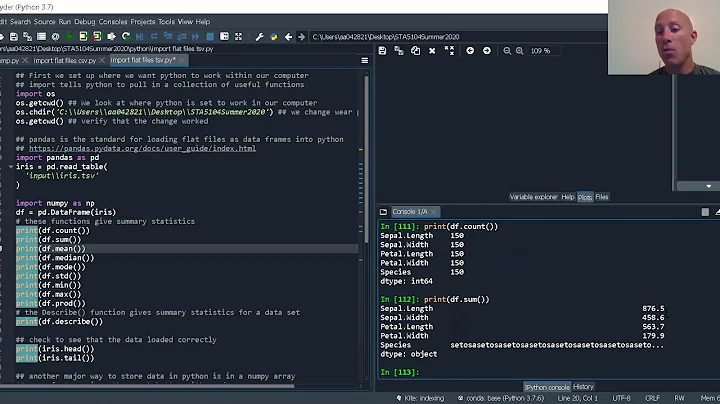Convert tab-delimited txt file into a csv file using Python
Solution 1
csv supports tab delimited files. Supply the delimiter argument to reader:
import csv
txt_file = r"mytxt.txt"
csv_file = r"mycsv.csv"
# use 'with' if the program isn't going to immediately terminate
# so you don't leave files open
# the 'b' is necessary on Windows
# it prevents \x1a, Ctrl-z, from ending the stream prematurely
# and also stops Python converting to / from different line terminators
# On other platforms, it has no effect
in_txt = csv.reader(open(txt_file, "rb"), delimiter = '\t')
out_csv = csv.writer(open(csv_file, 'wb'))
out_csv.writerows(in_txt)
Solution 2
This is how i Do it
import csv
with open(txtfile, 'r') as infile, open(csvfile, 'w') as outfile:
stripped = (line.strip() for line in infile)
lines = (line.split(",") for line in stripped if line)
writer = csv.writer(outfile)
writer.writerows(lines)
Solution 3
Why you should always use 'rb' mode when reading files with the csv module:
Python 2.7.2 (default, Jun 12 2011, 15:08:59) [MSC v.1500 32 bit (Intel)] on win32
Type "help", "copyright", "credits" or "license" for more information.
What's in the sample file: any old rubbish, including control characters obtained by extracting blobs or whatever from a database, or injudicious use of the CHAR function in Excel formulas, or ...
>>> open('demo.txt', 'rb').read()
'h1\t"h2a\nh2b"\th3\r\nx1\t"x2a\r\nx2b"\tx3\r\ny1\ty2a\x1ay2b\ty3\r\n'
Python follows CP/M, MS-DOS, and Windows when it reads files in text mode: \r\n is recognised as the line separator and is served up as \n, and \x1a aka Ctrl-Z is recognised as an END-OF-FILE marker.
>>> open('demo.txt', 'r').read()
'h1\t"h2a\nh2b"\th3\nx1\t"x2a\nx2b"\tx3\ny1\ty2a' # WHOOPS
csv with a file opened with 'rb' works as expected:
>>> import csv
>>> list(csv.reader(open('demo.txt', 'rb'), delimiter='\t'))
[['h1', 'h2a\nh2b', 'h3'], ['x1', 'x2a\r\nx2b', 'x3'], ['y1', 'y2a\x1ay2b', 'y3']]
but text mode doesn't:
>>> list(csv.reader(open('demo.txt', 'r'), delimiter='\t'))
[['h1', 'h2a\nh2b', 'h3'], ['x1', 'x2a\nx2b', 'x3'], ['y1', 'y2a']]
>>>
Related videos on Youtube
wilbev
Updated on October 13, 2020Comments
-
wilbev over 3 years
So I want to convert a simple tab delimited text file into a csv file. If I convert the txt file into a string using string.split('\n') I get a list with each list item as a string with '\t' between each column. I was thinking I could just replace the '\t' with a comma but it won't treat the string within the list like string and allow me to use string.replace. Here is start of my code that still needs a way to parse the tab "\t".
import csv import sys txt_file = r"mytxt.txt" csv_file = r"mycsv.csv" in_txt = open(txt_file, "r") out_csv = csv.writer(open(csv_file, 'wb')) file_string = in_txt.read() file_list = file_string.split('\n') for row in ec_file_list: out_csv.writerow(row) -
agf about 12 yearsDo you have a python.org reference for the Ctrl-z behavior? I don't see any mention of it.
-
John Machin about 12 years@agf: No. It's a consequence of CPython 2.X delegating responsibility for deciding what to do to the
Cstdiolibrary of the target compiler.










